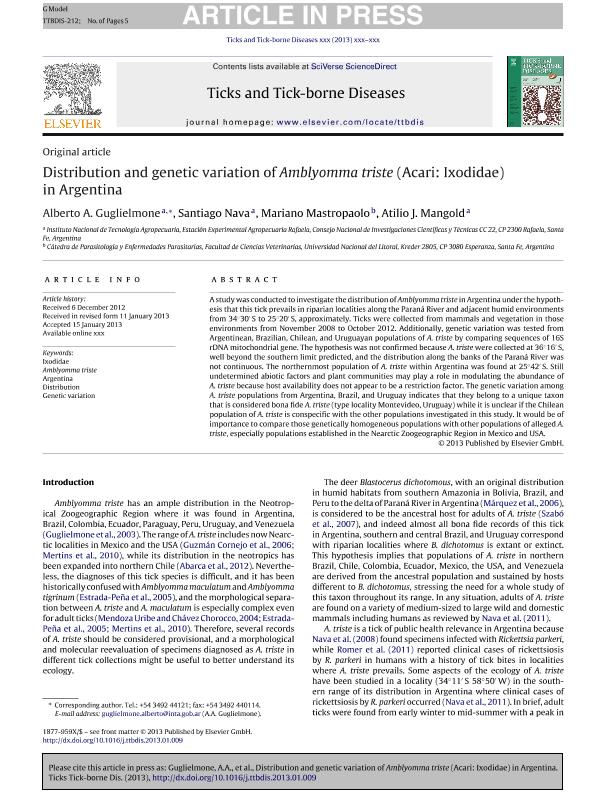Mostrar el registro sencillo del ítem
dc.contributor.author
Guglielmone, Alberto Alejandro

dc.contributor.author
Nava, Santiago

dc.contributor.author
Mastropaolo, Mariano

dc.contributor.author
Mangold, Atilio Jose

dc.date.available
2016-07-07T20:19:17Z
dc.date.issued
2013-09
dc.identifier.citation
Guglielmone, Alberto Alejandro; Nava, Santiago; Mastropaolo, Mariano; Mangold, Atilio Jose; Distribution and genetic variation of Amblyomma triste (Acari: Ixodidae) in Argentina; Elsevier; Ticks and tick-borne Diseases; 4; 5; 9-2013; 386-390
dc.identifier.issn
1877-959X
dc.identifier.uri
http://hdl.handle.net/11336/6401
dc.description.abstract
A study was conducted to investigate the distribution of Amblyomma triste in Argentina under the hypothesis that this tick prevails in riparian localities along the Paraná River and adjacent humid environments from 34°30′ S to 25°20′ S, approximately. Ticks were collected from mammals and vegetation in those environments from November 2008 to October 2012. Additionally, genetic variation was tested from Argentinean, Brazilian, Chilean, and Uruguayan populations of A. triste by comparing sequences of 16S rDNA mitochondrial gene. The hypothesis was not confirmed because A. triste were collected at 36°16′ S, well beyond the southern limit predicted, and the distribution along the banks of the Paraná River was not continuous. The northernmost population of A. triste within Argentina was found at 25°42′ S. Still undetermined abiotic factors and plant communities may play a role in modulating the abundance of A. triste because host availability does not appear to be a restriction factor. The genetic variation among A. triste populations from Argentina, Brazil, and Uruguay indicates that they belong to a unique taxon that is considered bona fide A. triste (type locality Montevideo, Uruguay) while it is unclear if the Chilean population of A. triste is conspecific with the other populations investigated in this study. It would be of importance to compare those genetically homogeneous populations with other populations of alleged A. triste, especially populations established in the Nearctic Zoogeographic Region in Mexico and USA.
dc.format
application/pdf
dc.language.iso
eng
dc.publisher
Elsevier

dc.rights
info:eu-repo/semantics/openAccess
dc.rights.uri
https://creativecommons.org/licenses/by-nc-nd/2.5/ar/
dc.subject
Ticks
dc.subject
Amblyomma
dc.subject
Triste
dc.subject.classification
Ciencias Veterinarias

dc.subject.classification
Ciencias Veterinarias

dc.subject.classification
CIENCIAS AGRÍCOLAS

dc.title
Distribution and genetic variation of Amblyomma triste (Acari: Ixodidae) in Argentina
dc.type
info:eu-repo/semantics/article
dc.type
info:ar-repo/semantics/artículo
dc.type
info:eu-repo/semantics/publishedVersion
dc.date.updated
2016-07-06T15:47:26Z
dc.journal.volume
4
dc.journal.number
5
dc.journal.pagination
386-390
dc.journal.pais
Países Bajos

dc.journal.ciudad
Amsterdam
dc.description.fil
Fil: Guglielmone, Alberto Alejandro. Instituto Nacional de Tecnologia Agropecuaria. Centro Regional Santa Fe. Estacion Experimental Agropecuaria Rafaela; Argentina. Consejo Nacional de Investigaciones Científicas y Técnicas. Centro Científico Tecnológico Santa Fe; Argentina
dc.description.fil
Fil: Nava, Santiago. Instituto Nacional de Tecnologia Agropecuaria. Centro Regional Santa Fe. Estacion Experimental Agropecuaria Rafaela; Argentina. Consejo Nacional de Investigaciones Científicas y Técnicas. Centro Científico Tecnológico Santa Fe; Argentina
dc.description.fil
Fil: Mastropaolo, Mariano. Universidad Nacional del Litoral. Facultad de Ciencias Veterinarias; Argentina
dc.description.fil
Fil: Mangold, Atilio Jose. Instituto Nacional de Tecnologia Agropecuaria. Centro Regional Santa Fe. Estacion Experimental Agropecuaria Rafaela; Argentina
dc.journal.title
Ticks and tick-borne Diseases
dc.relation.alternativeid
info:eu-repo/semantics/altIdentifier/url/http://www.sciencedirect.com/science/article/pii/S1877959X13000381
dc.relation.alternativeid
info:eu-repo/semantics/altIdentifier/doi/http://dx.doi.org/10.1016/j.ttbdis.2013.01.009
dc.relation.alternativeid
info:eu-repo/semantics/altIdentifier/doi/10.1016/j.ttbdis.2013.01.009
Archivos asociados
